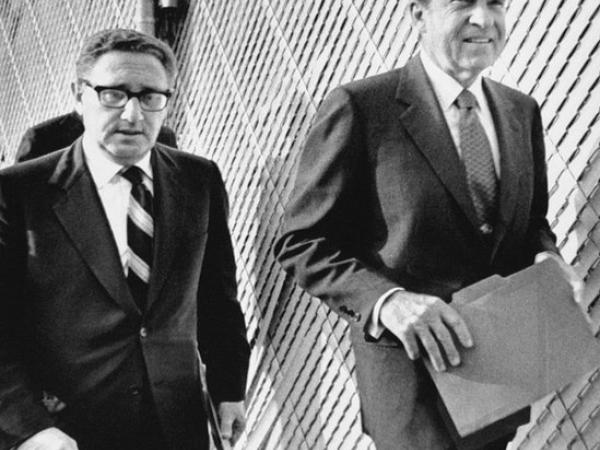The announcement came as a completely unexpected blow.
On the night of Sunday, August 15, 1971, United States President Richard Nixon interrupted prime-time television channels to deliver a message that would change the world economy forever.
“I have ordered the secretary [del Tesoro] Connally to temporarily suspend the convertibility of the dollar into gold,” the president said, putting an end to one of the foundations of the postwar international economy.
The measure was announced before 46 million viewers in the United States, but it went beyond the borders of the United States, especially among its allies, where it caused a real shock as it questioned their financial security and caught them completely off guard.
“Europe and Japan reacted with anxiety and confusion to President Nixon’s radical economic measures,” The New York Times reported then, noting that all major capitalist economic centers, with the exception of Tokyo, had suspended official transactions in their currencies.
Stock markets plunged, with Tokyo suffering the most.
The controversial measure announced by Nixon was part of a broader package of economic decisions that included the imposition of a 10% tax on imports, as well as the introduction of temporary price and wage controls to control inflation, which was later known as the “Nixon shock”.
“These policies were designed to prevent a run on US gold reserves and reverse the deterioration of the US balance of payments by getting other countries to revalue their currencies, as well as to prevent protectionist pressures in Congress,” economist Douglas A. Irwin wrote in an academic paper published in 2012 analyzing the impact of this package.
But what was this commotion about? Well, basically because it put an end to one of the foundations of the global capitalist economy since the end of World War II: the free convertibility of the dollar for gold.
To understand it, you have to go back to 1944.
In July 1944, in the final stage of World War II, representatives of 44 countries or allied governments participated in a conference in Bretton Woods (New Hampshire), in which the foundations were laid for what would be the reconstruction of the economy. post-war world, approving a project for the subsequent creation of the International Monetary Fund and the International Bank for Reconstruction and Development (which would later become part of what we know today as the World Bank).
Trade and lasting peace required financial stability. They needed a currency whose value everyone trusted, so within the Bretton Woods system it was decided that foreign currencies could be converted into dollars at fixed rates and that, in turn, US bills would be guaranteed to be converted into gold at a fixed rate. rate of US$35 per ounce of gold.
This means that having dollars was as good as having gold, so everyone used it in their trade relations and that trade fueled the economic recovery of Europe and Japan after the war.
However, in the early 1970s, Europe and Japan were enjoying a post-war economic boom, while the US was struggling.
The Vietnam War was enormously costly, inflation was rising, and while the gold standard deal was good for the rest of the world, it was hurting the US economy, which was headed dangerously toward collapse.
As early as the late 1960s, the amount of dollars outside the United States totaled nearly $50 billion, far exceeding the country’s gold reserves of about $10 billion.
“There was simply no way the United States could ever meet its obligation to exchange dollars for gold if other countries’ central banks started asking for gold in exchange for all of their dollar reserves,” said Douglas A. Irwin.
At the same time, at home, Americans were experiencing economic hardship, so Nixon was concerned that the situation might cost him the 1972 election. Plus, this was all in the middle of the Cold War, so the US president didn’t its economy could be allowed to begin to falter.
“The US government was faced with a situation akin to that of a child who has had a wonderful pair of shoes, but they have outgrown them. As economies like the US had grown rapidly, they had become out of sync with each other and was having too tight monetary policy because of the link to the gold standard. And that was creating a tremendous amount of friction,” Gillian Tett, US managing editor for the Financial Times, told History Hour. from the BBC.
Months before making this decision, the Nixon administration began weighing its options with its economic team, including former Texas Governor and Treasury Secretary John Connally and Paul Volcker, a senior Treasury official who years later he would become head of the Federal Reserve.
Volcker was a very tall man who was over six feet tall and very concerned with maintaining the stability of the international system, while Connally was a nationalist who had no problem shaking up the global consensus if it helped the United States.
The US president used to pay more attention to the second, whom he saw as a possible political successor in the White House.
“Nixon was won over by Connally’s tough attitude, his kind of Texan arrogance and the fact that he was extremely charismatic,” Bob Hormats, who had joined that economic team as an adviser to Henry Kissinger, told the BBC. then head of Homeland Security at the White House.
After months of discussions, on July 13, 1971, the team of advisers made a secret trip to Camp David, the country residence of the US Executive, where they finished specifying the plan on the measures that Nixon would announce.
After hearing Nixon’s announcement, Hormats says he asked if other governments had been notified before, but no one had done so because they wanted it to be a surprise.
“Then I thought, well, someone has to do this. So I said I would write a cable from the president to his counterparts abroad and I started getting frantic phone calls from the finance ministers of various countries,” he said.
“The main reaction was: ‘What happened? Tell us more, we need more details. This is going to have a big effect on us. We need to know. Why haven’t the Americans told us before?’ To all these questions I had to respond in my most diplomatic way,” he added.
The measures imposed not only meant that holders of US dollars no longer had the guarantee of being able to exchange them at the previously existing fixed rate, but also that their exports to the United States became more expensive and lost competitiveness due to the announced 10% tax.
Nixon had announced that this additional fee would be lifted when the “unfair treatment of the dollar” ended, something that the newspaper Le Monde denounced as “blackmail”.
France and Japan were loath to let their currencies “float” against the dollar, while shares in export-oriented companies like West Germany’s Volkswagen – which sold a third of its output in the US – saw their prices fall. shares on the stock market.
Over the next few months, Hormats, Volcker and Kissinger desperately tried behind the scenes to rebuild America’s broken relations with its allies and negotiated a new financial system.
“I had a conversation with Volcker and he said ‘well, I understand that the Japanese will be particularly affected directly, so I’ll go to Japan myself.’ he said ‘no, I’m going to wear a hat’. And I said ‘but you’re two meters tall, I don’t think you can go unnoticed for long’. But it turns out that he went and that he managed not to be discovered until he offered a wheel joint press release with the Japanese finance minister,” he said.
After months of negotiations, finally in December 1971, the United States and its allies announced an agreement for a new, more equitable monetary system.
“What has happened here is that the entire free world has won,” Nixon said after signing the agreement at the Smithsonian Institution in Washington.
That agreement, whereby the dollar was devalued 8.5% relative to gold while the currencies of the other 10 US allies were revalued against the US currency, only lasted 15 months before collapsing and, by 1973, most of those countries floated their currency against the dollar.
There are still debates surrounding the success of the “Nixon shock.” It saved the United States from a crisis, but it made the world economy more unstable. And it did not prevent inflation from continuing to plague the West during the 1970s.
One thing is certain, however: It marked a new world order, one in which the United States would no longer be carrying the West on its back.
*This piece is based on “Inflation and the cost of living” from the BBC’s History Hour programme. You can listen to the original in English here.
Now you can receive notifications from BBC News World. Download the new version of our app and activate it so you don’t miss out on our best content.
















